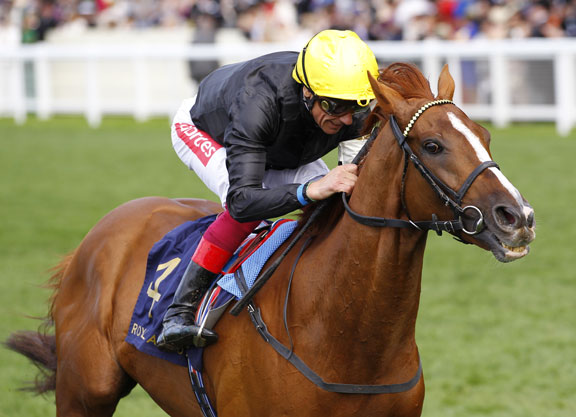By Andrew Caulfield
It was Shamardal who took the honours as the top stallion at Royal Ascot, with his four successes, and while I have no desire to detract from the achievements of a stallion who has already been featured twice in this column this year following the successes of Blue Point (Ire) and Skardu (Ire), I would point out that Shamardal had only one group winner at the Royal Meeting, albeit the outstanding dual winner Blue Point.
Sea The Stars (Ire), on the other hand, was the only stallion responsible for three individual group winners, with Stradivarius's heart-warming repeat victory in the G1 Gold Cup being preceded by Crystal Ocean (Ire)'s breakthrough success in the G1 Prince of Wales's S. and Star Catcher (GB)'s defeat of the Oaks third Fleeting (Ire) in the G2 Ribblesdale S. Even Sea The Stars's half-brother Galileo (Ire) couldn't quite match that treble, failing to add to the wins of Circus Maximus (Ire) and Japan (GB).
Incidentally, Galileo was also outpointed by his arch rival Pivotal (GB) in the role of broodmare sire, with Pivotal's daughters claiming three group successes, thanks to Raffle Prize (Ire), Advertise (GB) and Defoe (Ire), compared to Galileo's two, via Watch Me (Fr) and Space Traveller (GB).
Stradivarius has now won nine of his 11 starts over a mile and three-quarters or more, including six of his seven starts over two miles and beyond. After he had won over a mile as a 2-year-old, Timeform suggested that Stradivarius “will be suited by 1 1/4m+,” but who could have suspected that this Newcastle maiden winner would develop into such an exceptional long-distance performer?
I think it is fair to say that virtually no modern-day flat horses are bred with extreme distances in mind, but fortunately the dormant stamina lurking in pedigrees occasionally reawakens to stunning effect, as Stradivarius has demonstrated so admirably.
The bare facts of his pedigree are that his sire Sea The Stars– who was fast enough to win the 2,000 Guineas–was never asked to tackle more than a mile and a half, and his dam, Private Life (Fr), won over a mile and 1 3/8 miles before earning black-type over an extended mile and a half. Private Life's dam Poughkeepsie (Ire) raced only over a mile and a quarter, winning once at Evry, and none of Stradivarius's other grand-parents–the miler Cape Cross (Ire) and the major mile-and-a-half winners Urban Sea and Bering (GB)–was ever tried beyond a mile and a half.
So what are the likely sources of Stradivarius's ability to shine over two and a half miles? The prime suspect has to be Sadler's Wells, the sire of his second dam Poughkeepsie. Although the 14-time champion sire never won beyond a mile and a quarter in a career which featured victories in the Irish 2000 Guineas, the Eclipse and the Irish Champion S., that didn't stop his progeny establishing an average winning distance of 11.4 furlongs (compared to the 11.2 furlongs of his son Galileo and the 11.2 furlongs of Galileo's half-brother Sea The Stars). Needless to say, the finest stayers by Sadler's Wells included the multiple Gold Cup winners Yeats (Ire) and Kayf Tara (GB) and the Doncaster Cup winners Septimus (Ire) and Saddler's Rock (Ire).
There is also stamina to be found in the bottom half of the pedigrees of both of Stradivarius's parents. Sea The Stars's second dam, Allegretta, was by Lombard (GB), whose wins included the Deutsches St Leger, and his third dam, Anatevka, was by Espresso, who stayed a mile and three-quarters very well. Espresso was by Acropolis, whose brother Alycidon won the Gold Cup and sired a winner of the Gold Cup in Twilight Alley.
Stradivarius has a very distinguished third dam in Pawneese (GB), who won the Oaks by five lengths before inflicting the first defeat on the classic-winning Riverqueen (Fr) in the Prix de Diane. Pawneese then took on the males in the King George and put up a remarkable display of front-running to win again, in the process proving herself Europe's champion 3-year-old filly of 1976.
Brilliant though she was at her best, Pawneese had a comparatively undistinguished sire in Carvin. A winner of the Criterium de Saint-Cloud over a mile and a quarter as a 2-year-old and third in the Prix du Jockey-Club, Carvin later reached the frame in a pair of important 15-furlong races, the Grand Prix de Paris and the Prix Royal-Oak. Pawneese's broodmare sire, Le Haar, sired Ramsin, winner of the Prix du Cadran over the same distance as the Gold Cup.
Although Pawneese proved a major disappointment as a broodmare for Daniel Wildenstein, her Sadler's Wells filly Poughkeepsie made some amends. In addition to Stradivarius's dam, she produced the listed winner Parisienne, who ranks as the second dam of the Melbourne Cup and Grosser Preis von Berlin winner Protectionist (Ger). Stradivarius is the third very useful performer to have represented Private Life. Her Monsun (Ger) gelding Persian Storm (Ger) was a dual Group 3 winner over a mile and a quarter in Germany, while her Peintre Celebre gelding Rembrandt Van Rijn (Ire) stayed at least a mile and three-quarters in the UAE.
In assessing Sea The Stars's Royal Ascot treble, it is worth reminding everyone that Stradivarius and Crystal Ocean are both members of his fourth crop, which contained only 74 foals. Crystal Ocean and Stradivarius were separated by only a short head when second and third behind Capri (Ire) in the 2017 St Leger, but Crystal Ocean has been busily emphasising both his class and versatility, with two of his 2019 successes coming over a mile and a quarter.
Fortunately, Sea The Stars has received much more consistent support since the likes of Taghrooda (GB) and Sea The Moon (Ger) did so well for him at Classic level in 2014, and his Ribblesdale winner Star Catcher comes from a 2016 crop of 136. The 2018 Return of Mares credits the Gilltown star as having covered more than 160 mares in both the 2017 and 2018 seasons, so be prepared for plenty more Royal Ascot winners for Sea The Stars in years to come.
Not a subscriber? Click here to sign up for the daily PDF or alerts.






